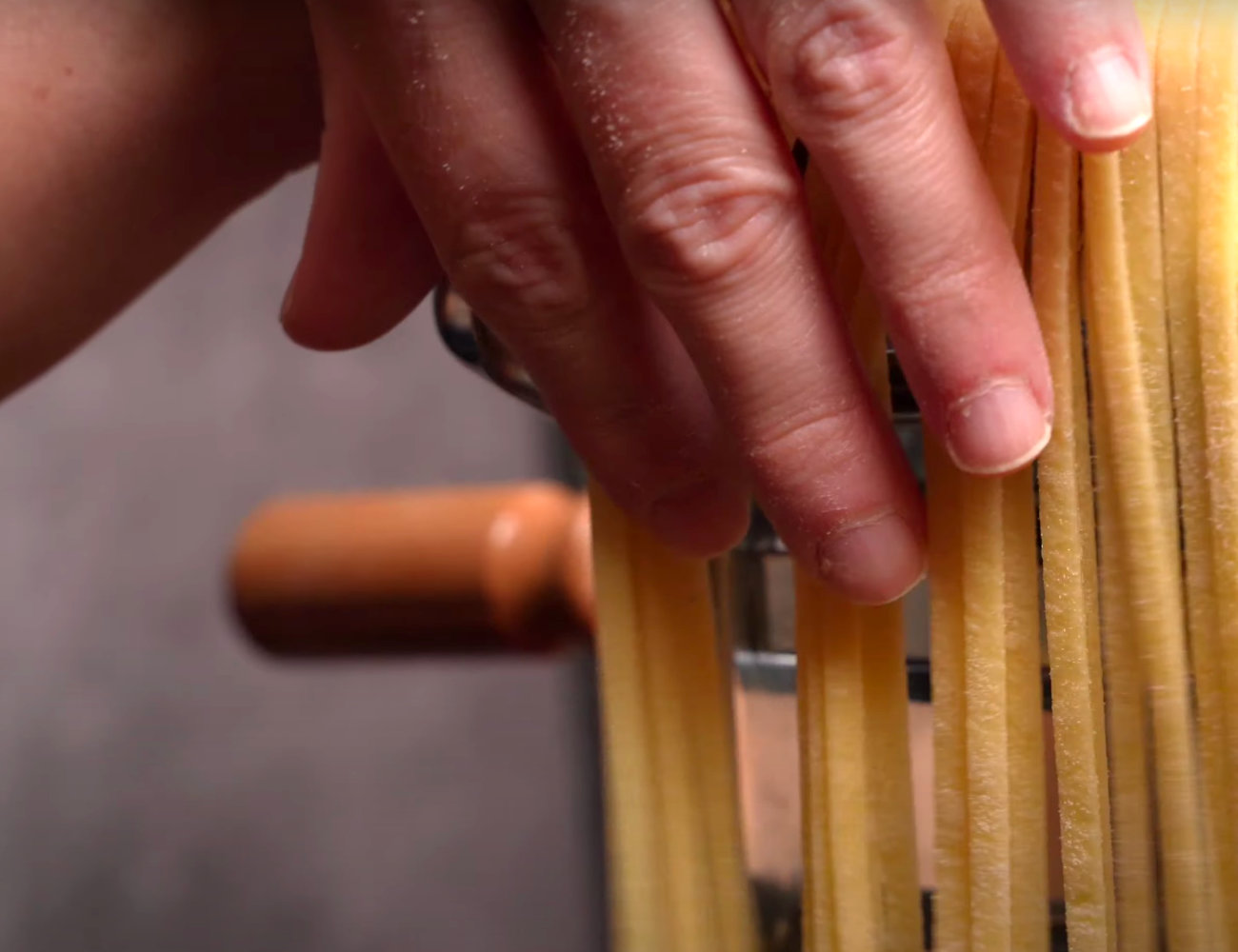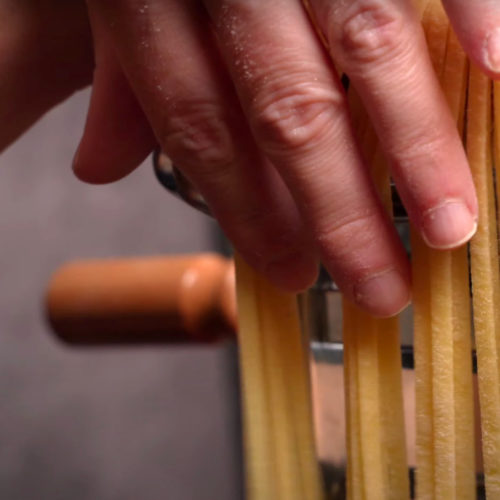Fresh egg pasta is a staple in Italy. It is surprisingly easy once you get the hang of it. Making fresh pasta is a great way to eat better and save money. We got this fresh egg pasta dough recipe from an expert: an Italian Grandma who makes it every week!

Watch the Video Recipe!
If you prefer to watch a video recipe, click on the video below.
Subscribe to our YouTube Channel
More video recipes? Subscribe to our YouTube Channel (it’s FREE) and click the bell to get notifications when we release a new video recipe!
How to Make Fresh Egg Pasta Dough: Tips
There’s a rule of thumb to keep in mind when making any fresh egg pasta dough recipe: Use 100 grams of flour for every one whole egg.
This amount makes pasta for about one person if pasta is the main dish.
We’ve all seen pasta pros making pasta the traditional way. They add a pile of flour to a work surface. Then, they make a well in the center of the pile of flour and add whole eggs to the well. Then, the eggs are beaten into the eggs, pulling flour in from the sides a little at a time until the dough is able to form a ball. Then the ball is kneaded until it is smooth and elastic. Presto: pasta dough!
Why is this the traditional way of making fresh pasta dough? While the rule of thumb is 100 grams of flour for every whole egg, the reality isn’t as precise. Types of flour differ in how much moisture they can absorb. Humidity and temperature can affect how the exact same flour absorbs the egg from one pasta making adventure to the next. Eggs vary in size.
For all of these reasons, pasta pros know that flour must be added in a bit at a time in order to judge how much flour is needed. Pulling flour in from the sides a little at a time lets them do just that!
This method of making fresh pasta dough is not difficult — you can watch Italian Grandma Lulu demonstrate how it’s done in the video we’ve embedded on this page.
However, the process can look intimidating if you are a beginner at making pasta. You might be wondering…How much flour do I mix in? How do I keep the eggs from running off the table? All these concerns can prevent you from getting down to the business of making pasta!
For this reason, we offer an alternative for mixing…
Making Fresh Egg Pasta Dough in a Bowl
Beginners will be relieved to know that pasta can be mixed in a bowl if you’d prefer. To do this, add 3/4 of the flour you expect you’ll need (just 75 grams per egg) to a large mixing bowl. Dump the rest of the flour onto the work surface where you’ll be kneading the dough.
Make a well, add the whole eggs and beat the eggs with a fork, incorporating them into the flour.
At this point, the dough will become shaggy looking. Press it into a loose ball and begin to knead it on the work surface. Too sticky? Add more flour and keep kneading. Still too sticky? Add more flour. Stop adding flour when you can knead the dough ball without it sticking to your hands.
The tips below for mixing flour in a bowl can also be used if you are making pasta dough in a stand mixer.
Start with 3/4 the flour. Add more if needed.
The biggest mistake you can make with fresh pasta is adding too much flour. It’s best to start with 3/4 of the flour recommended and add more as needed to achieve a smooth, elastic dough ball.
Pasta too dry? Try this!
If you don’t follow the tip above and end up with pasta that is too dry to stretch, you can add a few drops of water or olive oil to add some moisture.
Though many pros wouldn’t recommend this, home chefs do this when needed and the result is still delicious.
As an Amazon Associate, we earn from qualifying purchases. This means at no extra cost to you, PIATTO may earn a small commission if you click the links and make a qualifying purchase.
Fresh Egg Pasta Dough Recipe
Equipment
- Rolling Pin or Pasta Machine
Ingredients
- 400 g pasta flour alternatives: all-purpose or '00'
- 4 whole eggs
- 1 pinch fine salt (optional)
- 2 tsp olive oil (optional) extra-virgin
Instructions
Make the Pasta
- Add the flour in a pile to a work surface. Make a well in the center of the flour. Add the eggs to the center of the flour. Add the salt and olive oil (optional)Begin to beat the flour into the eggs with a fork, pulling the flour in from the sides a little at a time.400 g pasta flour, 4 whole eggs, 1 pinch fine salt, 2 tsp olive oil
- Using a stand mixer? Start with ¾ of the flour recommended and add more flour as needed. It’s better to start with too little flour than too much.
- When the dough begins to look shaggy, compress the dough into a loose ball and begin to knead. Knead the dough until it is smooth and elastic. When you push in on the dough, it should spring back.
- When the fresh pasta dough is ready, cover and let the dough rest for at least 30 minutes.
Stretch the Pasta
- Work with ¼ of the dough at a time. Keep those pieces you aren't working on covered or wrapped in plastic. This will prevent the pasta from drying out.
- Place ¼ of the dough on a well-floured surface. Flour both sides of the dough. Roll or press the dough into a ¼ inch (½ cm) thick rectangle.
- Pass the floured rectangle through a pasta roller, starting at the widest setting. Feed dough into machine short-side first. Then, place the dough lengthwise on the floured work surface. Fold the dough as you would a letter, starting with one side. Roll out the dough again till it is ¼ in (½ cm) thick.
- The short side of folded dough rectangle should be a little smaller than the width of your pasta roller. Then, pass the pasta through the roller again.Reduce the width of the pasta roller one setting. Pass the pasta through the roller again. Always feed the pasta in short-side firstPass the pasta through the roller, each time reducing the roller width one setting until the resulting pasta is the thickness required for the pasta you are making!


